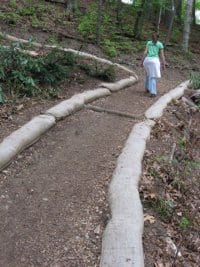Sustainable Practices for Ecosystem Restoration was held at Wellesley College on January 19, 2012.
Reviewed by Brandon Schmitt
Nearly 60 people joined together at the beautiful Wellesley campus to attend a discussion focused on erosion control and stormwater management led by employees of Groundscapes Express. The site was a perfect setting for the discussion, as the company had recently completed an erosion control project on the campus where adelgid infected Hemlocks were removed, entitling the attendees to a first-hand view of their methods. The opening slide of the presentation encouraged attendees to “Think Differently.” All too often, the presenters mentioned, a comprehensive restoration plan fails to address crucial issues including site protection measures, long-term invasive management, water management, and soil and plant issues.

FilterMitts™, burlap tubes filled with a compost-mulch blend, helps to stabilize a path on a slope. Photo by Nick Novick,courtesy of Groundscapes Express.
The presenters were huge advocates for biodegradable fencing and erosion measures versus petroleum products. A brilliant and economical means to this end was to use downed tree logs as check dams by pinning them to slopes. The presenters also pleaded for landscape restoration project managers to remember to ensure adequate control of invasives before any plantings are done, and to allocate resources for their future removal whenever possible. Their bottom line was that every NOI (Notice of Intent) should have an invasive maintenance plan written into it.
The most intriguing aspect of the presentation involved discussion of the use of a compost blanket and compost filled tubes for erosion control. This was really a great idea, as the compost is functional, and acts as a soil amendment that would take 40 years to be created naturally by normal leaf and woody debris composition. Mycorrhiza that live in the compost provide the webbing needed to hold the compost together and to the ground. Groundscapes’ compost blanket product takes 6-8 months to produce, and involves bringing the compost material to 140 degrees to sterilize any invasive materials. The presenters warned that many soil production companies and municipalities do not compost debris, but merely pile up waste, a practice that allows the invasives to spread when the material is used in future applications.
A final examination of an erosion control project using three methods was most telling. In that slideshow, three abutting properties used three methods, including plastic netting, plug planting, and the compost blanket method. The before and after photos show that the compost blanket was by far the most effective method and was accomplished without the use of the petroleum based products.
In summation, the presenters charge to “think differently” was wise, because as discussed, while many of the synthetic products that have been used for the past 50 years simply do not stop erosion, a naturally derived, environmentally safe, and functionally sound product does.
Groundscapes Express exhibits at the ELA Conference & Eco-Marketplace on March 8th. Visit them at Booth #502 to find out more about their products and services.
About the Author
Brandon Schmitt, originally from Ohio, is currently the Park ranger for the Town of Brookline, MA. Brandon is also a certified Arborist with the International Society of Arboriculture, and Certified Playground Safety Inspector.

